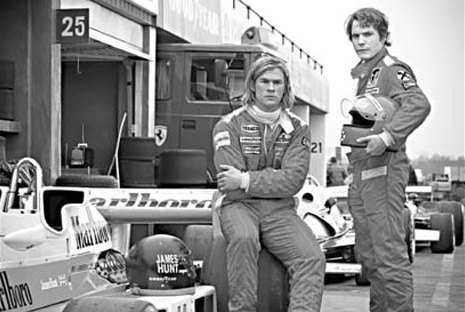Director shifts, to Europe and Formula One
Updated: 2013-09-29 07:26
By Charles McGrath(The New York Times)
|
|||||||
Ron Howard likes to think of himself as one of those chameleon directors, like Billy Wilder and Mike Nichols, who are known not for any one thing, but rather for doing lots of things well. His checklist includes whimsical comedies ("Cocoon" and "Splash"), a fairy tale ("Willow"), a space epic ("Apollo 13"), a biopic ("A Beautiful Mind"), a western ("The Missing") and two Dan Brown thrillers ("The Da Vinci Code" and "Angels & Demons").
Mr. Howard's newest film, "Rush," which was released globally, fills a tiny niche. It's a Formula One car racing movie.
Europe is where most of the money for "Rush" came from. It's the first movie that Mr. Howard, known mostly for his mainstream Hollywood hits, has made without America as the primary audience, and it shows. "Rush" is darker, sexier, moodier than any of his previous pictures. By Ron Howard standards, it's practically an art-house film.
The budget was $30 million, not a pittance by movie standards but hardly the kind of money Mr. Howard is used to for his movies.
|
"Rush," built around the real-life rivals James Hunt and Niki Lauda, stars Chris Hemsworth, far left, and Daniel Bruhl. Jaap Buitendijk / Universal Pictures |
Though Mr. Howard's first feature, "Grand Theft Auto" (1977), was essentially one long car chase, Mr. Howard is far from a car enthusiast. He seems less a big shot Hollywood director than a balding, bearded version of Opie Taylor, the character he played on the Andy Griffith television show in the 1960s. He admitted recently that for his 50th birthday, in 2004, his wife gave him a BMW 750 and after just a couple of months, he went back to his Volvo station wagon.
"I guess you could say it's a bit of a stretch," he said about making "Rush." "But at this point, I don't know what does sound like a Ron Howard film. I'm just looking for interesting filmmaking challenges and stories that have a chance to surprise the audience. "When I started," he added, "I didn't know much about Formula One, but I knew that it was cool, sexy and dangerous, and that's a pretty good combination."
He prepped for the movie by studying "Senna," Asif Kapadia's 2010 documentary about the great Brazilian driver Ayrton Senna, and by looking at racing movies old and new, even "Talladega Nights." Because "Rush" is set in the '70s, he also watched and rewatched "Gimme Shelter," the 1970 Rolling Stones documentary, which may account for why, in yet another departure, "Rush" has something Mr. Howard's movies are seldom known for: a look. The movie, shot by Anthony Dod Mantle (who won an Oscar for "Slumdog Millionaire"), is so bright at times as to be almost psychedelic, and at others dark and muted, as if shot through a haze of marijuana smoke.

Mr. Howard said the screenplay and the chance to work with the screenwriter Peter Morgan were what attracted him to the project. (Mr. Morgan also wrote the script, based on his own stage play, for Mr. Howard's film "Frost/Nixon.") But Mr. Morgan wrote the first draft of "Rush" assuming that there might not be any racing sequences at all.
"I wasn't sure there would be the money," he said by phone from Vienna, where he lives half the year with his wife, who is Austrian. "So I said to myself, 'Why don't we work on the assumption that racing is going to be impossible?'"
Instead, Mr. Morgan structured the whole film as a kind of race between the two principal characters, James Hunt (played by Chris Hemsworth, better known as Thor in "The Avengers") and Niki Lauda (Daniel Bruhl, a Spanish-born German actor), drivers who were real-life rivals in the late '70s. Mr. Hunt, an Englishman, was charming and glamorous, a blond, carefree lothario, irresistible to women. Mr. Lauda, an Austrian, was socially awkward and obsessive about the mechanical details of racing and the risks, which he endlessly recalculated.
Mr. Hunt died (of a heart attack) in 1993, but Mr. Lauda, who became a wealthy man in the airline business after retiring from racing, is still alive and cooperated in the making of the film.
In a phone conversation, Mr. Lauda said: "I had been approached before, but the ideas always seemed to me boring. Peter Morgan and Ron Howard - these are the right people. Ron Howard had no idea about racing. He was like a little kid, with unbelievable enthusiasm. But the story comes very well across."
The racing scenes had to be shot quickly without much room for mistakes, Mr. Howard said, both for budgetary reasons and logistical ones.
Most Formula One tracks are booked for much of the year. And though the film crew had some original cars from the period, there were limits to how many kilometers they could put on them. The replica cars, on the other hand, broke down just as frequently as the real ones.
"It was daunting," Mr. Howard said. "But I think daunting is a good thing when it comes to making movies."
The New York Times
(China Daily 09/29/2013 page12)
